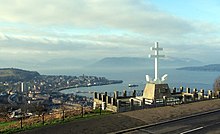Lyle Hill
Car parking spaces give views to the west, and a short distance further down the road the Free French Memorial is in the shape of the Cross of Lorraine combined with an anchor.
Across the road, steps and a rough path lead up to a viewpoint at Craigs Top with views up the River Clyde as far as Glasgow.
Spellings included the Binghans, Bingans, Bingins, Bingens, and Binyans, and it was suggested that this came from the Gaelic Binneans with the meaning of little hills.
[19] John Marius Wilson in his 1860 Hand-Book To Scotland: For Tourists described the "small modern fortification" of Fort Matilda as set "on a point of land projecting from the base of Binnan's Hill", and said that "Binnan's Hill rises behind it with precipitous crest, and commands a fine view of the Clyde from Dumbarton to Dunoon.
He inherited a Greenock cooperage business, and in 1865 had co-founded a sugar refining partnership at the Glebe refinery (visible from the start of Lyle Road).
With others, they promptly set up a six hole golf course on land leased from Bow Farm, but this ended after three years when the tenant farmer applied cattle manure.
[27] During World War II most of the golf course was occupied by Site Cz4 Z Battery, anti-aircraft rockets defending the area against Luftwaffe raids (such as the Greenock Blitz).
Spread across the hill, the battery had four projectile rocket launchers, each of which was set on a circular base and surrounded by four ammunition huts.
[29] At a ceremony held on 15 January 1946, the memorial was unveiled by A. V. Alexander, First Lord of the Admiralty,[30] in the presence of officers and ratings from both the Royal Navy and the French Forces.
[33] After the Countryside Commission for Scotland offered grant-aid in 1980, lnverclyde District Council carried out major improvements to the Lyle Hill car parking and viewpoint.
[34] Annual Remembrance Sunday commemoration ceremonies take place at the Free French Memorial; in 2016 the occasion also marked 70 years since its unveiling.
Also visible are the Cowal hills, with the town of Dunoon below, the Holy Loch, former site of the US Navy Scottish submarine base and the settlements of Kilcreggan, Rosneath and Helensburgh to the east.
Immediately to the north of the hill Greenock's Battery Park provides level playing fields, bounded on the west by Gourock's Cardwell Bay and on the east by the former torpedo factory, now occupied by warehousing and a housing development, and the Navy Buildings for long occupied by HM Coastguard.
They stand at Ironotter Point which in the late 18th century was the site of a coastal gun battery called Fort Matilda, a name now given to the area, to the railway station just to the north of Lyle Hill and to the playing pitch of the local rugby side, the Greenock Wanderers.













